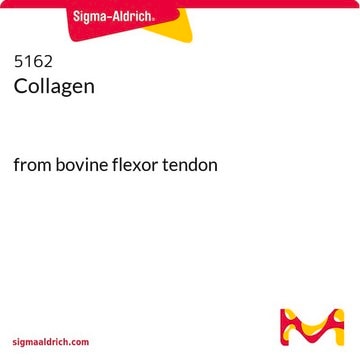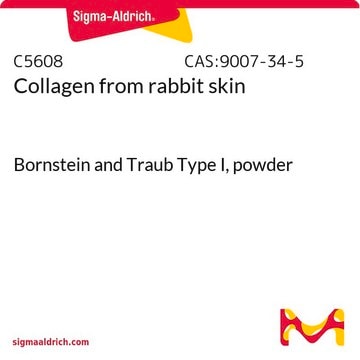11179179001
Roche
Collagen
from rat tail tendon
Synonym(s):
collagen
Sign Into View Organizational & Contract Pricing
All Photos(1)
About This Item
UNSPSC Code:
12352207
Recommended Products
biological source
rat tail
Quality Level
sterility
sterile
form
lyophilized (clear, colorless solution after reconstitution)
packaging
pkg of 30 mg
manufacturer/tradename
Roche
technique(s)
cell culture | mammalian: suitable
UniProt accession no.
storage temp.
2-8°C
Gene Information
rat ... Col1a1(29393)
General description
Collagens are abundantly present in vertebrates. 41 specific genes codes for 42 polypeptide chains and produce 27 collagen types. Collagens are mainly present in the extracellular matrix. Collagen type I is abundantly present in mammals. Type IV collagen is an important structural protein of basement membranes. It is chemically and genetically different from stroma collagen types I and III and cartilage collagen type II.
Specificity
Active on most mammalian cells.
Application
Collagen has been used in the preparation of coverslip coating solution and collagen gel contraction assay.
Collagen is used as a substrate for culturing a variety of cells, such as coating of culture dishes and the preparation of collagen gels.
Biochem/physiol Actions
Collagen provides extracellular support for multicellular animals. Collagen type I offers mechanical stability, strength and toughness to a range of tissues from tendons and ligaments, to skin, cornea, bone and dentin.
Features and Benefits
Contents
Lyophilizate, cell culture grade, 3 vials of 10mg
Lyophilizate, cell culture grade, 3 vials of 10mg
Specifications
Biological activity: Tested for the promotion of adherence of HUV-EC cells.
Preparation Note
Working concentration: 5 μg/cm2
5 μg/cm2 for the coating of cell culture vessels; for the preparation of collagen gels, a final concentration of 2 to 3 mg/ml is used.
5 μg/cm2 for the coating of cell culture vessels; for the preparation of collagen gels, a final concentration of 2 to 3 mg/ml is used.
Reconstitution
IFor best results, dissolve the lyophilizate in 0.2% acetic acid (v/v) solution.
For the preparation of collagen gels, the content of the bottle should be dissolved in 3.3 ml sterile 0.2% acetic acid (v/v) each. This results in a final concentration of 3 mg/ml.
For coating culture dishes the final concentration should be 1 to 2 mg/ml.
Note: For dissolving: do not stir, just pour the acetic acid onto the lyophilizate and allow it to stand for several hours until it has dissolved. To completely dissolve the product an incubation for up to a maximum of 24 hours at 15 to 25 °C may be required.
Reconstitution of the Collagen should be done at 15 to 25 °C, higher temperatures destroy the fibres and may prevent the subsequent gelation of the Collagen.
For the preparation of collagen gels, the content of the bottle should be dissolved in 3.3 ml sterile 0.2% acetic acid (v/v) each. This results in a final concentration of 3 mg/ml.
For coating culture dishes the final concentration should be 1 to 2 mg/ml.
Note: For dissolving: do not stir, just pour the acetic acid onto the lyophilizate and allow it to stand for several hours until it has dissolved. To completely dissolve the product an incubation for up to a maximum of 24 hours at 15 to 25 °C may be required.
Reconstitution of the Collagen should be done at 15 to 25 °C, higher temperatures destroy the fibres and may prevent the subsequent gelation of the Collagen.
Other Notes
For life science research only. Not for use in diagnostic procedures.
Storage Class Code
11 - Combustible Solids
WGK
WGK 1
Flash Point(F)
does not flash
Flash Point(C)
does not flash
Certificates of Analysis (COA)
Search for Certificates of Analysis (COA) by entering the products Lot/Batch Number. Lot and Batch Numbers can be found on a product’s label following the words ‘Lot’ or ‘Batch’.
Already Own This Product?
Find documentation for the products that you have recently purchased in the Document Library.
Customers Also Viewed
Calcium-based nanoparticles accelerate skin wound healing.
Kawai K, et al.
PLoS ONE, 6(11), e27106-e27106 (2011)
Roman G Szafran et al.
Molecules (Basel, Switzerland), 26(21) (2021-11-14)
In this study, we thoroughly analyzed molecular gradient generation, its stability over time, and linearity in our high-throughput drug screening microfluidic assay (HTS). These parameters greatly affect the precision and accuracy of the device's analytical protocol. As part of the
Collagen cross-links, 207-229 (2005)
Collagen: Primer in Structure, Processing and Assembly (2005)
Identification and analysis of a novel dimerization domain shared by various members of JNK scaffold proteins.
Cohen-Katsenelson K, et al.
The Journal of Biological Chemistry (2013)
Our team of scientists has experience in all areas of research including Life Science, Material Science, Chemical Synthesis, Chromatography, Analytical and many others.
Contact Technical Service










